
Radzyń Podlaskipronounced [ˈrad͡zɨɲ pɔdˈlaskʲi] is a town in eastern Poland, about 60 km north of Lublin, with 15,808 inhabitants (2017). Situated in the Lublin Voivodeship since 1999, previously it was part of the Biała Podlaska Voivodeship (1975–1998). It is the capital of Radzyń Podlaski County, and historically belongs to the region of Lesser Poland. The town was founded in 1468, and its most important landmark is the rococo Potocki Palace.

Branicki Palace is a historical edifice in Białystok, Poland. It was developed on the site of an earlier building in the first half of the 18th century by Jan Klemens Branicki, a wealthy Polish–Lithuanian Commonwealth hetman, into a residence suitable for a man whose ambition was to become king of Poland. The palace complex with gardens, pavilions, sculptures, outbuildings and other structures and the city with churches, city hall and monastery, all built almost at the same time according to French models was the reason why the city was known in the 18th century as Versailles de la Pologne and subsequently Versailles de la Podlachie.
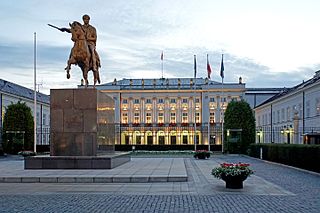
The Presidential Palace is the official residence of the Polish head of state and president alongside the Belweder Palace, located in Warsaw, Poland. Originally constructed in 1643 as an aristocratic mansion, it was rebuilt and remodelled several times over the course of its existence by notable architects. The current neoclassical palace was completed in 1818.
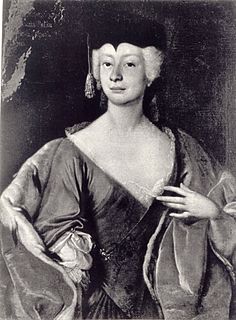
Princess Konstancja Czartoryska was a Polish-Lithuanian noblewoman and the mother of king Stanisław August Poniatowski. She played a political role as a driving force within the Familia.

Wilanów Palace is a former royal palace located in the Wilanów district of Warsaw, Poland. Wilanów Palace survived Poland's partitions and both World Wars, and so serves as a reminder of the culture of the Polish state as it was before the misfortunes of the 18th century.
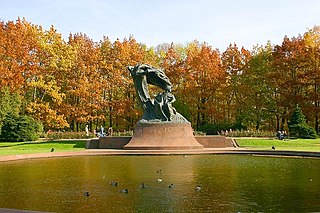
Łazienki Park or Royal Baths Park is the largest park in Warsaw, Poland, occupying 76 hectares of the city center.
The Polish Baroque lasted from the early 17th to the mid-18th century. As with Baroque style elsewhere in Europe, Poland's Baroque emphasized the richness and triumphant power of contemporary art forms. In contrast to the previous, Renaissance style which sought to depict the beauty and harmony of nature, Baroque artists strove to create their own vision of the world. The result was manifold, regarded by some critics as grand and dramatic, but sometimes also chaotic and disharmonious and tinged with affectation and religious exaltation, thus reflecting the turbulent times of the 17th-century Europe.

Neoclassical architecture in Poland was centered on Warsaw under the reign of Stanisław August Poniatowski, while the modern concept of a single capital city was to some extent inapplicable in the decentralized Polish–Lithuanian Commonwealth. Classicism came to Poland in the 18th century as the result of French infiltrations into the Polish millieu. The best-known architects and artists who worked in Poland were Dominik Merlini, Jan Chrystian Kamsetzer, Szymon Bogumił Zug, Stanisław Zawadzki, Efraim Szreger, Antonio Corazzi, Jakub Kubicki, Hilary Szpilowski, Christian Piotr Aigner, Wawrzyniec Gucewicz, Bonifacy Witkowski and Danish Bertel Thorvaldsen.

The Branicki Palace is an 18th-century magnate's mansion in Warsaw, Poland. It is located at the junction of Podwale and Miodowa Streets.
Jan de Witte (1709–1785) was a Polish military engineer, professional officer and architect of Dutch descent. The designer of, among others, the Dominican church in Lwów and the Carmelite monastery in Berdyczów, he was also the military commandant of the fortress at Kamieniec Podolski.

Tylman van Gameren, also Tilman or Tielman and Tylman Gamerski, was a Dutch-born Polish architect and engineer who, at the age of 28, settled in Poland and worked for Queen Marie Casimire, wife of Poland's King John III Sobieski. Tylman left behind a lifelong legacy of buildings that are regarded as gems of Polish Baroque architecture.
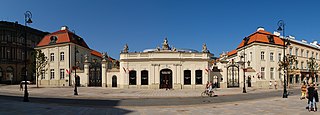
Potocki Palace, is a large baroque palace in Warsaw located at Krakowskie Przedmieście Street 15, directly opposite the Presidential Palace. It was originally built for Denhoff family and succeeded by Potocki family in the end of 18th century. After World War II the seat of the Ministry of Culture and Art. Nowadays - the Ministry of Culture and National Heritage.
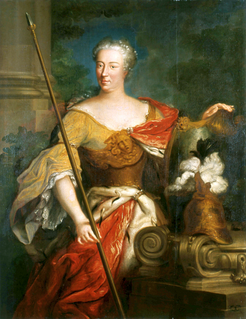
Elżbieta Helena Sieniawska, née Lubomirska, was a Polish noblewoman, Grand Hetmaness of the Crown, and a renowned patron of the arts.
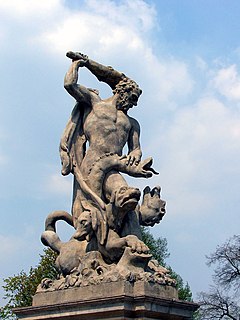
Jan Chryzostom Redler, also Johann Chrysostomus Redler, was a Polish sculptor. His exact date of birth or death is not known. He worked mainly in Warsaw and Białystok.

Palace at Otwock Wielki or Otwock Grand Palace is otherwise known as the Jezierscy Family palace or Bielińscy Family palace. It is a historic palatial residence located on an artificial island in an oxbow lake of the River Vistula in Otwock Wielki, in the gmina Karczew, powiat otwocki, masovian Voivodeship.

Radzyń Podlaski Castle is a complex of a palace and castle built between 1685 and 1709, and expanded between 1750 and 1759.

The Lubomirski Palace in Opole Lubelskie, Lublin Voivodship, Poland, is a much-altered 18th-century palace formerly belonging to the Słupecki and Lubomirski families.

Józef Fontana II was a Swiss Italian Polish architect and the father of architects, Jakub Fontana and Jan Kanty Fontana.

Młodziejowski Palace (Pałac Młodziejowskiego, Polish pronunciation: [ˈpawat͡s mwɔd͡ʑɛjɔvˈskʲɛɡɔ], also the Morsztyn Palace, is a palace located in Warsaw at 10 Miodowa Street, with annexes at 7 Podwale Street. The palace was erected in the Baroque style at the end of the 17th century. It is adjacent to the Branicki and Szaniawski palaces.





















